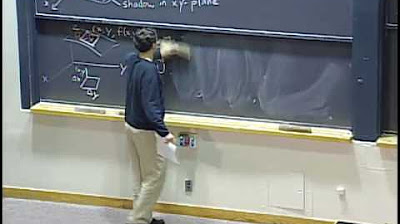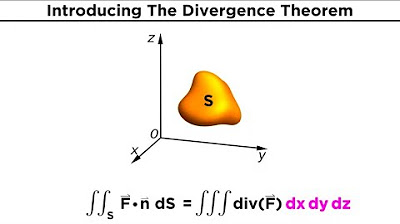Divergence theorem proof (part 1) | Divergence theorem | Multivariable Calculus | Khan Academy
TLDRThis script delves into the proof of the divergence theorem, a fundamental concept in vector calculus. It explains how the flux across a surface, represented by the dot product of a vector field F and the normal vector n, is equivalent to the triple integral of the divergence of F over the volume. The explanation assumes a simple solid region, which can be categorized as type I, II, or III, and breaks down the vector field F into its components. The script aims to show that the surface integral of the components of F, each multiplied by the corresponding component of n, equals the sum of the triple integrals of the partial derivatives of F's components, thus confirming the divergence theorem.
Takeaways
- 📚 The script is discussing the proof of the divergence theorem, a fundamental concept in vector calculus.
- 🌀 The divergence theorem relates the flux of a vector field across a surface to the volume integral of the divergence of the field.
- 📐 The flux is represented as the dot product of the vector field F and the normal vector n, integrated over the surface area ds.
- 🔍 The proof assumes a 'simple solid region' which can be categorized as type I, II, or III, encompassing basic shapes like spheres and cylinders.
- 📘 The vector field F is decomposed into its i, j, and k components, represented by functions P(x, y, z), Q(x, y, z), and R(x, y, z) respectively.
- 📝 The dot product F dot n is expanded to show the contribution of each component of F and the normal vector n.
- 📈 The left-hand side of the divergence theorem is expressed as a surface integral, broken down into components of P, Q, and R.
- 📉 The right-hand side involves the volume integral of the divergence of F, calculated as the sum of partial derivatives of P, Q, and R with respect to x, y, and z.
- 🔄 The proof strategy involves showing that the corresponding terms on both sides of the equation are equal, using the properties of type I regions.
- 📚 The proof leverages the fact that the region is a type I region to establish the equivalence of the surface and volume integrals.
- 🔑 The script suggests that similar arguments can be made for type II and type III regions to complete the proof of the divergence theorem.
Q & A
What is the divergence theorem?
-The divergence theorem states that the flux of a vector field across a closed surface is equal to the triple integral of the divergence of the vector field over the volume enclosed by the surface.
What is meant by the term 'flux' in the context of the divergence theorem?
-Flux in this context refers to the quantity of a vector field that passes through a given surface, which is represented as the dot product of the vector field and the normal vector to the surface, integrated over the surface area.
What does the notation F dot n represent?
-F dot n represents the dot product of the vector field F and the normal vector n to the surface. This product is used to calculate the component of the vector field that is perpendicular to the surface.
What is a 'simple solid region' in the context of the divergence theorem?
-A simple solid region is a type of region that can be classified as type I, II, or III, which includes basic geometric shapes like spheres or cylinders. These regions have well-defined boundaries and are used to simplify the application of the divergence theorem.
What are the types of regions mentioned in the script, and how do they relate to the divergence theorem?
-The types of regions mentioned are type I, II, and III. These classifications are used to categorize regions based on their geometric properties and boundaries, which helps in applying the divergence theorem by breaking down complex regions into simpler ones.
How is the vector field F represented in the script?
-In the script, the vector field F is represented as the sum of its components in the x, y, and z directions, each multiplied by their respective unit vectors i, j, and k, and functions P(x, y, z), Q(x, y, z), and R(x, y, z).
What is the significance of the dot product in calculating F dot n?
-The dot product is significant because it allows us to find the component of the vector field F that is perpendicular to the surface by multiplying the components of F with the corresponding components of the normal vector n.
What does the divergence of a vector field represent?
-The divergence of a vector field represents the rate at which the vector field is spreading out or converging at a given point, calculated as the sum of the partial derivatives of the field's components with respect to each spatial dimension.
How is the divergence theorem applied to a type I region?
-For a type I region, the divergence theorem is applied by breaking down the surface integral of the vector field into components and showing that each component is equal to the corresponding triple integral of the divergence of the vector field's components over the volume.
What is the purpose of rewriting the surface integral and the triple integral in the script?
-The purpose of rewriting the integrals is to demonstrate that the surface integral of the vector field components, when dotted with the normal vector, is equivalent to the sum of the triple integrals of the divergence of each component over the volume, thus proving the divergence theorem.
How does the proof of the divergence theorem relate to the properties of the normal vector?
-The proof involves the normal vector because it is crucial in determining the direction and magnitude of the vector field's components that contribute to the flux across the surface, which is then related to the volume integral of the divergence.
Outlines
📚 Introduction to the Divergence Theorem
This paragraph introduces the divergence theorem, which is a fundamental concept in vector calculus. It explains that the theorem relates the flux of a vector field F across a surface to the volume integral of the divergence of F within that region. The explanation begins by defining the flux as the dot product of F and the normal vector n, multiplied by the differential surface area ds. The paragraph assumes a simple solid region, which can be classified as type I, II, or III, and includes basic shapes like spheres and cylinders. The vector field F is expressed in terms of its components along the coordinate axes, and the dot product F dot n is expanded to show its components. The goal is to prove the theorem by showing that the surface integral of F dot n is equal to the volume integral of the divergence of F.
🔍 Expanding the Divergence Theorem's Expressions
This paragraph continues the discussion on the divergence theorem by breaking down the expressions for both the surface integral and the volume integral. The left-hand side of the equation, representing the surface integral, is expanded to show the contributions from each component of the vector field F along the normal vector n. The right-hand side of the equation, representing the volume integral, is expanded using the divergence of F, which is expressed as the sum of partial derivatives of the components P, Q, and R with respect to their respective coordinates x, y, and z. The paragraph aims to prove the theorem by demonstrating that the corresponding terms on both sides of the equation are equal, focusing on the type I region to establish the equivalence between the surface and volume integrals. The proof strategy involves showing that the integrals of the components of F along the normal vector n are equal to the integrals of the partial derivatives of the components of F within the volume.
Mindmap
Keywords
💡Divergence Theorem
💡Vector Field
💡Flux
💡Normal Vector
💡Dot Product
💡Divergence
💡Triple Integral
💡Type I, II, and III Regions
💡Partial Derivative
💡Surface Integral
💡Differential Cube
Highlights
Introduction to the divergence theorem and its significance in vector calculus.
Explanation of the flux across a surface in relation to a vector field F.
Description of the normal vector n and its role in calculating flux.
Assumption of dealing with a simple solid region, including types I, II, and III.
The proof of the divergence theorem using the flux integral and volume integral.
Decomposition of vector field F into components P, Q, and R.
Calculation of F dot n, the dot product of the vector field and the normal vector.
Simplification of the surface integral expression using the dot product.
Rewriting the left-hand side of the divergence theorem as a sum of integrals.
Definition of the divergence of F in terms of partial derivatives.
Restatement of the divergence theorem using triple integrals.
Strategy to prove the theorem by showing equivalence of corresponding terms.
Use of the type I region assumption to establish the proof's foundation.
Potential extension of the proof to type II and type III regions.
The importance of understanding the components of the vector field in the proof.
Insight into how the divergence theorem relates to the geometry of the region.
Final remarks on the proof's completion and its implications for vector calculus.
Transcripts
Browse More Related Video

Divergence theorem example 1 | Divergence theorem | Multivariable Calculus | Khan Academy

Lec 28: Divergence theorem | MIT 18.02 Multivariable Calculus, Fall 2007

The Divergence Theorem

Lec 29: Divergence theorem (cont.): applications & proof | MIT 18.02 Multivariable Calculus, Fall 07

2D divergence theorem | Line integrals and Green's theorem | Multivariable Calculus | Khan Academy

Divergence theorem proof (part 2) | Divergence theorem | Multivariable Calculus | Khan Academy
5.0 / 5 (0 votes)
Thanks for rating: